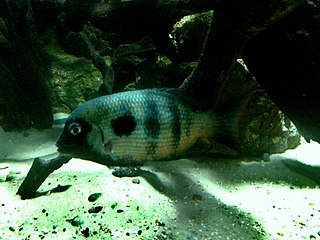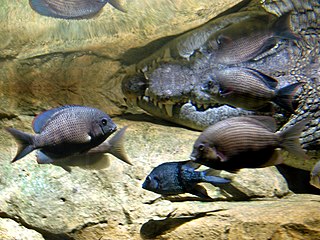Paretroplus dambabe is an endangered species of cichlid from the Mahavavy du Sud river basin, including Lake Kinkony, in northwestern Madagascar. It has declined drastically due to habitat loss, invasive species and over-fishing. This relatively large and deep-bodied Paretroplus reaches almost 19 centimetres (7.5 in) in length. Although collected as early as the 1960s, it was long confused with P. petiti and therefore only described as a species in 2002.

Paretroplus is a genus of fishes in the cichlid family, all of which are endemic to lakes and rivers of Madagascar. The vast majority are threatened and restricted to the northwestern part of the island. Only P. polyactis is found in the southern half of Madagascar and only P. polyactis and P. gymnopreopercularis are found in eastern drainages. Most are restricted to freshwater, but at least P. polyactis and P. maromandia can also be seen in brackish habitats.

The kotsovato is a species of cichlid from northwestern Madagascar. As presently defined its range spans several river basins, but this could possibly include more than one species. It is threatened by habitat loss and competition from introduced species. This relatively elongate Paretroplus reaches about 16 centimetres (6.3 in) in length and is closely related to P. gymnopreopercularis, which it resembles. The specific name honours the French fisheries scientist André Kiener.

The damba mipentina is a critically endangered species of cichlid fish from turbid, shallow flood-plain lakes in the Betsiboka and Ikopa River basins in northwestern Madagascar. It has declined drastically because of habitat loss, overfishing and invasive species. It is part of a captive breeding program by public institutions like London Zoo and among fishkeeping hobbyists.
Paretroplus maromandia is an endangered species of cichlid fish from fresh and brackish water in northwestern Madagascar, where known from the Maintsomalaza, Andranomalaza and Maevarano Rivers, and Lake Andrapongy. It has already been extirpated from the lake, and is threatened by habitat loss and invasive species. This relatively deep-bodied Paretroplus reaches 25 centimetres (9.8 in) in length.
Paretroplus nourissati, the lamena, is a species of cichlid from the vicinity of the confluence of the Amboaboa and Mangarahara Rivers near Mandritsara in northern Madagascar. This relatively elongate Paretroplus reaches about 16 centimetres (6.3 in) in length, and is closely related to P. lamenabe and P.tsimoly. P. nourissati is threatened by habitat loss and invasive species.
The kotso is a species of cichlid fish from northwestern Madagascar. Currently rated as data deficient by the IUCN, this species is virtually unknown. The only known specimen is a juvenile that was collected more than 80 years ago. It is not entirely clear where it was collected, but likely from the Maintimaso River or Lake Ambanja, which both are part of the Betsiboka River drainage. Erroneously, the name P. petiti has often been applied to members of a different species, P. dambabe. The specific name honours the French zoologist and anatomist Georges Petit (1892-1973) of the Muséum national d’Histoire naturelle, who collected type.

Paretroplus polyactis is a vulnerable species of cichlid found widely in fresh and brackish water in coastal regions and associated river basins in eastern Madagascar. It is the only Paretroplus found in the southern half of Madagascar, and one of only two found in eastern drainages. P. polyactis is threatened by habitat loss and overfishing. This relatively deep-bodied Paretroplus reaches 30 centimetres (12 in) in length. It shares a large part of its range with a cichlid from another genus, Ptychochromis grandidieri.
Paretroplus lamenabe is a species of cichlid from the lower part of the Mahajamba River and Lake Tseny in northwestern Madagascar. Until its official scientific description in 2008, it was popularly known as the "Giant Lamena". As suggested by this name, it is a relatively large Paretroplus of the lamena group, reaching almost 20 centimetres (7.9 in) in length. This relatively elongate Paretroplus is closely related to the smaller P. nourissati and P. tsimoly.
Paretroplus tsimoly is a species of cichlid fish from the Betsiboka River basin in northwestern Madagascar. Like other members of the lamena group, it is a rheophile. This relatively elongate Paretroplus reaches about 16 centimetres (6.3 in) in length, and is closely related to P. lamenabe and P. nourissati.

Ptychochromis grandidieri is a species of fish in the family Cichlidae endemic to river basins along a large part of the eastern coast of Madagascar, although it has been recorded as far as 100 km (62 mi) inland. Uniquely in the genus Ptychochromis, this species also occurs in brackish water. It reaches 21.3 cm (8.4 in) in standard length. It shares a large part of its range with a cichlid from another genus, Paretroplus polyactis. The specific name honours Alfred Grandidier (1836-1921), the French naturalist and explorer who, with Henri Joseph Léon Humblot (1852-1914), collected the type.

Ptychochromis is a genus of cichlids endemic to rivers and lakes in Madagascar. One species can also be seen in brackish water. Most species in this genus are threatened, and P. onilahy is probably extinct. Most reach a length of 12–15 cm (4.7–5.9 in), but P. insolitus only reaches 5.5 cm (2.2 in), while P. grandidieri and P. oligacanthus reach 21–25 cm (8.3–9.8 in).
Ptychochromis inornatus is an endangered species of cichlid endemic to the Ankofia River basin and its tributaries in the eastern part of the Mahajanga Province in Madagascar. It is threatened by habitat loss. It reaches 12.2 cm (4.8 in) in standard length.

Ptychochromis oligacanthus is a species of cichlid endemic in fresh water habitats in the western part of the Antsiranana Province in Madagascar. The population on the island of Nosy Be appears to be stable, but the mainland populations are threatened by habitat loss. It reaches a length of 25 centimetres (9.8 in) TL.
Ptychochromis loisellei is a species of cichlid from the Mahanara River basin north of Sambava in northeastern Madagascar. It remains common within its small range, but it is threatened by habitat loss and introduced species. It reaches about 11.9 centimetres (4.7 in). The similar named Paretroplus loisellei is also restricted to the Mahanara River basin. The specific name honours Paul V. Loiselle, Emeritus Curator of Freshwater Fishes at the New York Aquarium and a researcher in, and campaigner for the conservation of, the freshwater fish of Madagascar.
Ptychochromis onilahy is a species of cichlid endemic to the Onilahy River in southwestern Madagascar. Despite several recent visits to the region, this species has not been recorded since 1962 when the only known five specimens were collected. It is listed as extinct by the IUCN, but the Onilahy River system is large, and there is a small chance remnant populations exist in remote regions. This species can reach a length of 8.6 centimetres (3.4 in) SL.
Sauvagella robusta is a small species of fish in the family Clupeidae. It is endemic to the Amboaboa and Mangarahara River Basins in northern Madagascar. This relatively slender fish reaches a length of 6.8 cm (2.7 in), and is overall pale yellowish with silvery on the lower parts. Its current conservation status is unclear, but the cichlid Ptychochromis insolitus, which is highly threatened from habitat loss, is native to the same region. Sauvagella robusta is known to survive at least in Lake Tseny.

Ptychochromis insolitus, also known as the Mangarahara cichlid or joba mena, is a species of cichlid endemic to certain river systems in northern Madagascar. This critically endangered fish is threatened by habitat loss and competition from introduced species; after the last-known female was killed during a breeding attempt, its conservation received significant international attention as London Zoo launched a media campaign to identify any remaining individuals. A remnant population was discovered by aquaculture entrepreneur Guy Tam Hyock in 2013, and breeding programs in Madagascar and at Toronto Zoo have resulted in thousands of successful hatchlings.
Ptychochromis makira is a species of cichlid only known from the Antainambalana River in the northernmost part of the Toamasina Province in Madagascar. It is threatened by habitat loss and overfishing, and has suffered a severe decline in recent years. It reaches a length of 14.6 centimetres (5.7 in) SL.
Paretroplus loisellei is a vulnerable species of cichlid fish from the Mahanara River basin north of Sambava in northeastern Madagascar. Until its scientific description in 2011, this population was usually referred to as Paretroplus sp. nov. "Ventitry" or included in P. damii, which it resembles. It reaches about 15 centimetres (5.9 in) in length, and is threatened by habitat loss and introduced species. The similar named Ptychochromis loisellei is also restricted to the Mahanara River basin. The specific name honours Paul V. Loiselle, Emeritus Curator of Freshwater Fishes at the New York Aquarium and a researcher in, and campaigner for the conservation of, the freshwater fish of Madagascar.







